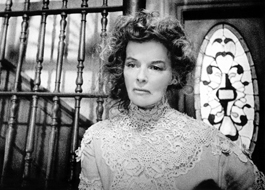home | metro silicon valley index | movies | current reviews | film review

Matriarch in autumn: Katharine Hepburn slowly unravels during the painful hours of 'Long Day's Journey Into Night.'
Nerves
Sidney Lumet's 'Long Day's Journey Into Night' is a dysfunctional family circus
By Richard von Busack
FIRST, there is the photography. Boris Kaufman, the cinematographer on L'Atalante and On the Waterfront, shoots the doomed quartet of the Tyrones through their many moods, from frenzy to despair. In his memoirs, director Sidney Lumet claimed that it drove him crazy to hear Long Day's Journey Into Night dismissed as a mere filmed Eugene O'Neill play. "It was the most complex camera and editing techniques I've ever done," Lumet wrote, and he explained that the real challenge was changing the time from morning to midnight in one set. He asks the viewers to juxtapose the Tyrones as they are near sunrise with how ruined they appear at midnight, after a long day of drinking, dreaming and abrading each others' nerves. The Stanford Theatre revives the 1962 film this week.
At first, Kaufman bathes the family in natural seaside light. As noon approaches, the glare is bounded with dark shadows. Inside, the depth of field is so short that the figures look like white paper dolls against the interiors of their shabby Victorian. One detail: the railings and banisters behind the Tyrones are unnaturally high and close-set; we are watching a cage match. The next-to-last shot has been duplicated many times: a pullback that leaves the central figures shipwrecked, far away in a soundless sea of black. Writing about it later, Lumet recalled the shot and the fadeout. What he didn't write about is the shock of the subsequent close-up that yanks the viewer back to the Tyrone's table, so that the film actually ends with the sound of Hepburn's final soft words. The juxtaposition of darkness and sudden grace is astonishing.
But how sane is Tyrone matriarch Mary, even in the morning? The freckled skin is too tight, twitching as Mary's veins are beginning to insist on a snack. Her equine friskiness comes across as slightly frightful. She is a horse you wouldn't go near, for fear of its hooves and its teeth. As the evening grows, as she floats on her cloud of morphine, she is still not at peace. She harps upon the loss of God and her life in the cloister. Her spouse, James Tyrone (Ralph Richardson), enjoys what is today called denial. He is a stuffed-shirt hack actor who prostituted himself into a very small fortune. Their eldest son, who despises his father's self-satisfaction is the hopeless drunk James Jr. (Jason Robards). Jamie's one triumph in life was making his sickly brother, Edmund (Dean Stockwell), his disciple, ruining the boy's health and his hopes.
One can nibble on a few corners of this production. The score by Andre Previn is 15 minutes of dissonant solo piano, and that's about 15 minutes too much. And at first, the acting styles don't seem to converge. Richardson excelled in playing covert and delusional little men, and he has the perfect pasteboard theatricalism for the part, but once you've heard that Hepburn wanted Spencer Tracy for the role, it's hard to get the vision out of your head. It would have been the finest moment of the Tracy-Hepburn partnership. Tragedy is a hard sell, but it's only failed tragedy that's depressing. Long Day's Journey Into Night is the kind of detailed tragedy that serves as a mirror. In varying angles, one views the way it was, maybe as it was in your own life—the way it might have been, and the way it might have been so much worse.
![]() Long Day's Journey Into Night plays June 20–21 at 7:30pm at the Stanford Theatre in Palo Alto.
Long Day's Journey Into Night plays June 20–21 at 7:30pm at the Stanford Theatre in Palo Alto.
Send a letter to the editor about this story.
|
|
|
|
|
|